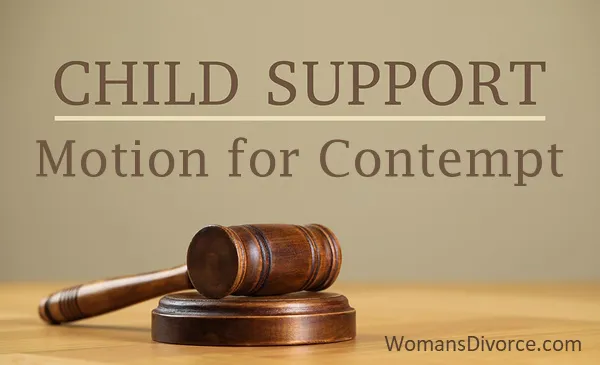- Home
- Child Support
- Child Support Contempt of Court
Using Contempt of Court Child Support Proceedings to Collect What You’re Owed
Wondering what you can do when your ex ignores the child support order? Find out how contempt of court child support actions can help you collect what is owed, legally and effectively. The article below discusses the rules for using this method of enforcement and how to file a motion for contempt to begin collecting back child support.
Quick Links:
- Using the Motion for Contempt to Collect Child Support
- The Basic Rules for a Motion for Contempt
- Contempt of Court Consequences and Penalties
- FAQs about Contempt of Court Child Support Proceedings
It's important to note that the process for using contempt of court proceedings to collect child support can vary significantly by state. You should consult with a skilled attorney or check your local court's specific rules to know what to expect.
Using the Motion for Contempt to Collect Child Support
by Howard Iken, J.D.

In family law cases, if there are minor children there is child support. And most states now require an order for support anytime the court considers children's issues. But unfortunately, getting an order for child support and collecting child support are two separate jobs. A common procedure for enforcing child support is the Motion for Contempt.
A brief description of the Motion for Contempt:
Your old case is reopened and a Motion for Contempt is filed. The Motion is a request to the court to force someone to comply with the terms of a previous court order - such as the payment of child support. A hearing must follow the filing of the Motion, usually thirty minutes in length.
The Basic Rules for a Motion for Contempt are:
- There must be a court order and that court order must be clear and understandable;
- The opposing party is not complying with the court order;
- You previously made some sort of gesture to encourage compliance (such as a simple letter);
- The opposing party must have the capability to comply with the court order and is purposefully refusing to comply.
Many states have available self-help forms that are valid for family law cases. Among those forms you may be able to find a generic "Motion for …" that you can turn into a Motion for Contempt. In that Motion, you must say facts that lay out conditions one through five, the requirements for a Contempt Order.
An example:
- An order was entered on January 1st, 20__ for child support in the amount of $999 monthly. That order is attached.
- The Respondent is in arrears in the amount of $9999 as of the date of this Motion.
- A good faith letter requesting payment was mailed to the Respondent on March 1st, 20__.
- The Respondent has not replied to that letter.
- The Respondent is earning $999/week and has the present ability to comply with the order.
After the Motion is filed, you must call the judge (or follow your local procedure) to schedule a hearing. You must also mail everyone, including the court, a Notice of the date of the hearing.
Contempt of Court Consequences and Penalties
If the other parent if found in contempt of the child support order, the judge can:
- Order the immediate payment of the money.
- Send the non-complying party to jail, contingent on payment of a specified sum.
- Order liquidation or sale of assets in sufficient amount to comply with the order. You must identify existing assets and give proof to the judge.
- Suspend driver licenses or other professional licenses.
- Issue an Income Deduction Order. Another common name for this is a garnishment order. This order allows direct debit from the Respondent's payroll check.
- Redirect child support to be paid through a state agency, sometimes called state disbursement units.
Every state is slightly different so you should do more research before taking these steps. Also, many states have a child support enforcement agency that will help you enforce support. The pros and cons of these services is a topic for another day.
Other options include private attorneys, and paralegal services. The main thing is to do your research, make your plan, and then move forward with your case.
Copyright: The Divorce Center PA. Information provided by Howard Iken, Orlando Divorce Attorney (800-469-3486).
FAQs about Contempt of Court Child Support Proceedings
Can I file for contempt without a lawyer?
Can I file for contempt without a lawyer?
While it is advisable to have an attorney handle everything for you, you can also represent yourself in contempt proceedings. But, you need to be aware that filing on your own can lead to complications or mistakes that could affect the outcome of your case.
If you want to proceed without legal assistance, you can begin by filling out the necessary forms, which are often available at the courthouse or through your local child support enforcement agency. Here is a good overview of how to file a Motion for Contempt of Court to help you get started.
What does "serving" the other party entail?
What does "serving" the other party entail?
You must let the other person know you have filed a motion for contempt so they can appear in court and defend themselves. The papers are generally served to the other person by a sheriff's deputy or a process server.
What evidence do I need for a contempt hearing?
What evidence do I need for a contempt hearing?
You need to have a copy of the original court order for child support. You also need to prove that the other parent has the financial ability to pay child support but is not complying with the child support order
How long does the contempt of court process usually take?
How long does the contempt of court process usually take?
The timeframe for contempt of court child support proceeding can vary greatly from several weeks to many months. After the contempt motion is filed, the other party typically has about 30 days to respond after being served. Then there is generally a waiting period while the court schedules a hearing, which can take quite some time depending on the court's caseload. Factors like local court rules, the complexity of the case, and how quickly parties file documents and respond can impact the overall timeline.
What happens if the other parent still doesn't pay after being found in contempt?
What happens if the other parent still doesn't pay after being found in contempt?
If a parent continues to not pay after being found in contempt, the court can escalate enforcement with measures like wage garnishment, license suspension, seizure of assets, and more severe penalties. Continued non-compliance can lead to criminal charges, fines, and potential jail time, as the judge may become frustrated and seek to enforce the court's authority more strictly.
The above article is a good overview on how the child support Contempt of Court process works. The following articles offer more information on child support and ways to collect what is owed...
